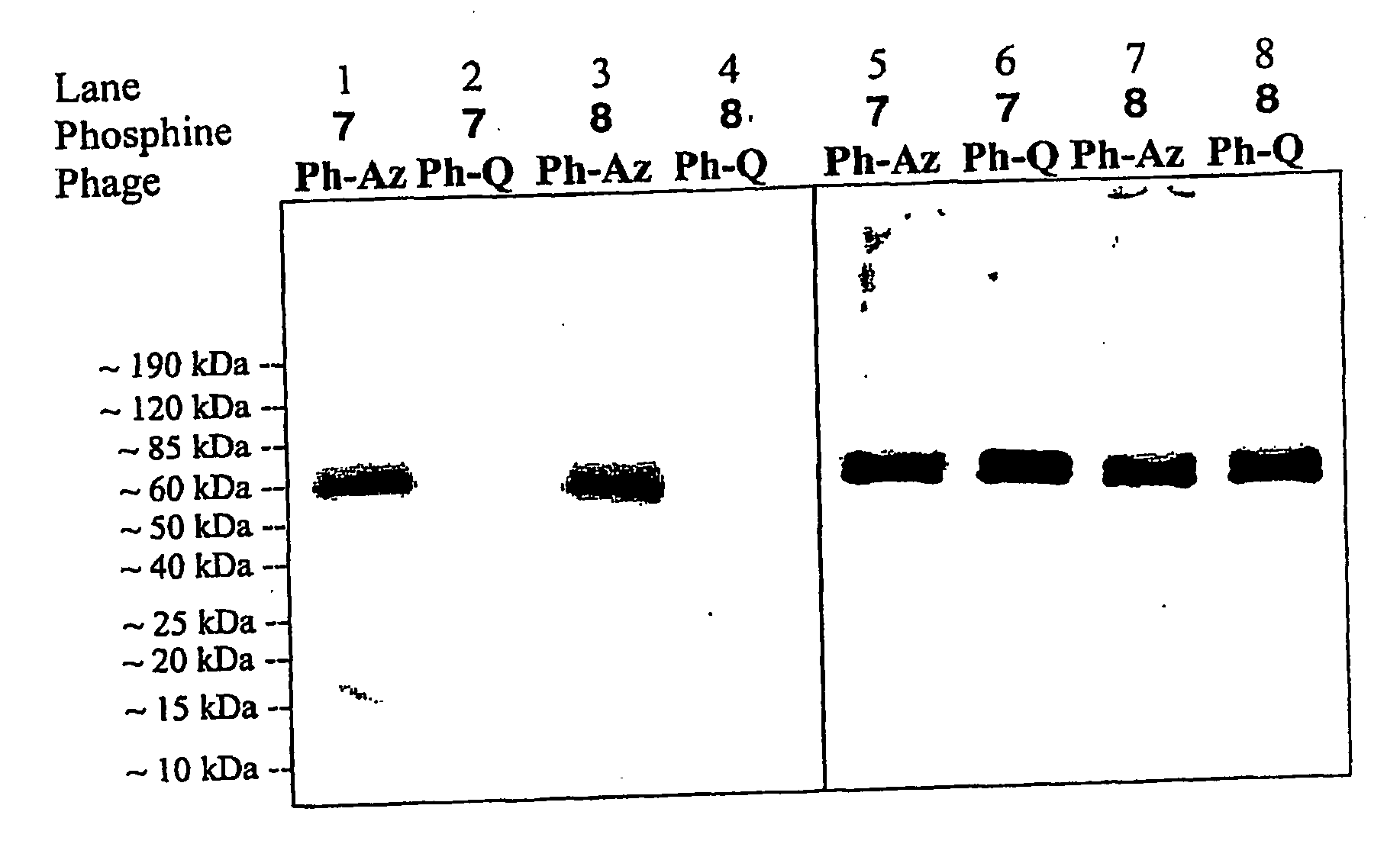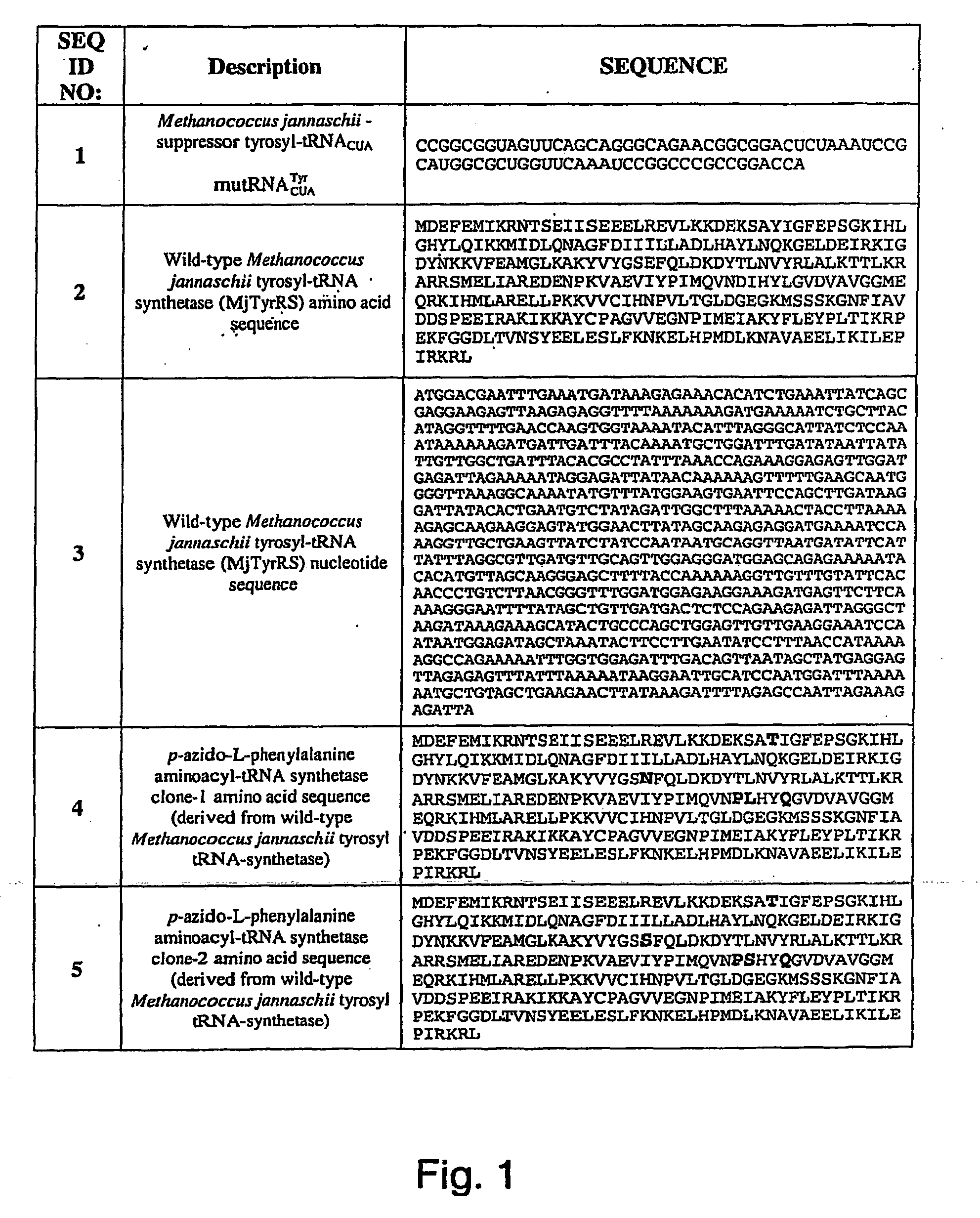Selective Posttranslational Modification of Phage-Displayed Polypeptides
a polypeptide and phage technology, applied in the field of protein chemistry, can solve the problems of limited natural amino acid residues and poor selectivity of most reactions currently used in the art for selective modification of proteins, and achieve the effects of facilitating detection or quantification, facilitating fabrication, and facilitating placemen
- Summary
- Abstract
- Description
- Claims
- Application Information
AI Technical Summary
Benefits of technology
Problems solved by technology
Method used
Image
Examples
example 1
The Generation of Phage Displayed Polypeptides Comprising Unnatural Amino Acids
[0281]The present Example describes compositions and methods for the generation of phage displayed polypeptides comprising unnatural amino acids. As described previously, orthogonal translation components can be used in suitable host cells to selectively introduce any of a large number of unnatural amino acids into proteins in vivo with good efficiency and high fidelity. As described herein, these orthogonal translation components and methodologies can be adapted for use in phage display systems as a general approach to the generation of phage-displayed polypeptide libraries containing unnatural amino acid building blocks.
[0282]Two plasmids, pDULE / CM and M13KE, were used to generate phage that display polypeptides containing unnatural amino acids as fusions to the pIII protein of the M13 filamentous phage. Plasmid pDULE / CM, which has a p15A origin, constitutively expresses a Methanococcus januaschii amber...
example 2
Plasmid Constructions
[0284]The present Example describes the construction of the plasmids used to expresses the orthogonal tRNA and orthogonal aminoacyl tRNA synthetase in E. coli host cells.
Construction of Plasmid pDULE / CM
[0285]Plasmid pDULE with an ampicillin resistant marker was digested with Bsm I and treated with Mung Bean nuclease to create a blunt end. The resulting DNA was digested with Cla I and purified by agarose gel electrophoresis. The chloramphenicol acetyltransferase gene was amplified from plasmid pACYC184 (NEB) by PCR using the primers:
PrimerSequenceSEQ ID NO:FT185′-GACAGCTTATCATCGATGAGACGTTGATCGGCACGTAAG12FT195′-GGTTGGTTTGCGCATTCAGCGCTAACCGTTTTTATCAGGC13
[0286]The PCR product was digested with Cla I and ligated with the pDULE to give pDULE / CM. The TTS cell line was generated by transformation of plasmid pDULE / CM into Top 10 F′ (Invitrogen).
Construction of pM13KE-SBP Plasmid:
[0287]The streptavidin binding peptide pIII fusion was prepared using extension primer FT121:...
example 3
Phage Culture and Phage Titering Protocols
[0288]The present Example describes the general methodologies of phage culture and titering as used herein.
General Phage Production Protocol in E. coli XL1-Blue
[0289]A single phage plaque was added to 10 mL of 2xYT containing mid-log E. coli strain XL1-Blue and 12 μg / mL of tetracycline. After incubation at 37° C. for 5 hrs, the culture was centrifuged at 6000×g, at 4° C. for 5 min. Phage was precipitated from the supernatant with 20% volume PEG buffer (20% PEG 8000, 2.5 M NaCl). The mixture was kept at 4° C. overnight and centrifuged at 10,000×g for 10 min at 4° C. The phage pellet was dissolved in 500 μL of 1×PBS, pH 7.4, centrifuged at 20,000×g for 10 min at 4° C. to remove the remaining cell debris, and stored at 4° C.
General Phage Production Protocol in E. Coli TTS
[0290]A single phage plaque was added to 10 ml of 2xYT containing mid-log ITS and 12 μg / mL of tetracycline, 34 μg / mL chloramphenicol and 2 mM of appropriate unnatural amino aci...
PUM
| Property | Measurement | Unit |
|---|---|---|
| structure | aaaaa | aaaaa |
| chemical properties | aaaaa | aaaaa |
| electrophilic | aaaaa | aaaaa |
Abstract
Description
Claims
Application Information
 Login to View More
Login to View More - R&D
- Intellectual Property
- Life Sciences
- Materials
- Tech Scout
- Unparalleled Data Quality
- Higher Quality Content
- 60% Fewer Hallucinations
Browse by: Latest US Patents, China's latest patents, Technical Efficacy Thesaurus, Application Domain, Technology Topic, Popular Technical Reports.
© 2025 PatSnap. All rights reserved.Legal|Privacy policy|Modern Slavery Act Transparency Statement|Sitemap|About US| Contact US: help@patsnap.com



